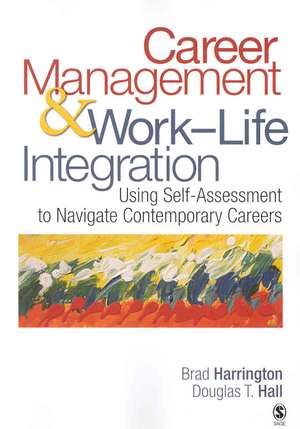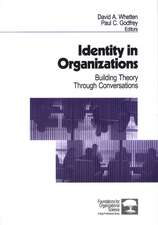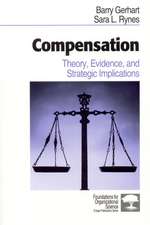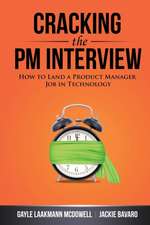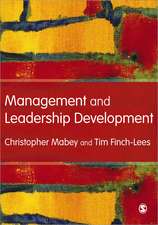Career Management & Work-Life Integration: Using Self-Assessment to Navigate Contemporary Careers
Autor Brad Harrington, Douglas T. Hallen Limba Engleză Paperback – 9 iul 2007
Preț: 712.17 lei
Preț vechi: 975.59 lei
-27% Nou
Puncte Express: 1068
Preț estimativ în valută:
136.30€ • 141.92$ • 115.19£
136.30€ • 141.92$ • 115.19£
Carte tipărită la comandă
Livrare economică 10-24 martie
Preluare comenzi: 021 569.72.76
Specificații
ISBN-13: 9781412937450
ISBN-10: 1412937450
Pagini: 248
Dimensiuni: 178 x 254 x 13 mm
Greutate: 0.44 kg
Ediția:1
Editura: SAGE Publications
Colecția Sage Publications, Inc
Locul publicării:Thousand Oaks, United States
ISBN-10: 1412937450
Pagini: 248
Dimensiuni: 178 x 254 x 13 mm
Greutate: 0.44 kg
Ediția:1
Editura: SAGE Publications
Colecția Sage Publications, Inc
Locul publicării:Thousand Oaks, United States
Recenzii
"Back around the turn of the century, I was on the Alliance for Work-Life Progress board, and some of the board members found their jobs and offices being downsized as a fairly lengthy recession set in. I have been in touch with many of these folks since then, and they have all done well, but mainly by changing careers. What they really needed was Career Management and Work-Life Integration, by Brad Harrington and Douglas Hall (2007). As the authors note, job ladders inside of corporations (and job security) are largely a thing of the past. For young or mature adults, the implications of that shift are enormous. Specializing can be dangerous, and making yourself indispensable may not be a great idea. So individual career planning becomes on one level more difficult and less useful because the unexpected is always just around the corner, but on another level far more important if you don't want to end up stuck doing work you don't like for a company you like even less... And this really is a work-family book, which is anything but surprising once you take in the implications of modern careers: the difficulties of navigating contemporary careers are heavily compounded for modern families, where dual-earners are the norm, and fathers as well as mothers expect to devote substantial time to children and, increasingly, elderly parents and relatives. And corporate work-life policies become important for a reason that is often downplayed: attracting talent. My reading of most of the literature on the business case for work-life is that it tends to emphasize talent retention. But that may be the wrong angle if the problem is getting the right people, and planning on fairly short 'career' duration. I should mention that much of the book is very much practical, with exercises designed to draw out the reader's values, aspirations, history, and family situation in order to make sense of -- and plan for -- the future. I highly recommend it for that practical
purposes, but genuinely enjoyed it as a contribution to rethinking the way work & family will play out in the future. Great stuff!”
"Its key features develop a bridge between theory and application, offering a rigorous self-assessment process and providing a more thorough experiential view than most existing books."
purposes, but genuinely enjoyed it as a contribution to rethinking the way work & family will play out in the future. Great stuff!”
"Its key features develop a bridge between theory and application, offering a rigorous self-assessment process and providing a more thorough experiential view than most existing books."
Cuprins
Preface
Acknowledgments
1. Understanding the New Career
Three Career Cases
The Barnes Family
Helen Casey
The Smith Family
The Changing Landscape of Careers
The Changing Nature of Families
The New Careers
Our Career and Work-Life Model
2. The Self-Assessment Process
The Basic Areas of Self-Assessment
Reflecting on the Past
Identity as a Core Competence
Clarifying Your Values
Understanding Your Interests and Passions
Lifestyle
Understanding Life Goals and Personal Vision
Skills Assessment
Summary
3. Integrating Your Self-Assessment and Developing Implications
Integrating Your Self-Assessment
Developing Themes from Your Data
Step 1: Coding Your Data
Step 2: Grouping Your Data
Step 3: Assigning Tentative Themes
step 4: Constructing the Final Themes With Supporting Data
Sample Themes
Developing Career and Work-Life Implications
Summary
4. Finding Ideal Work
Job Loss
Assessing the Labor Market
Identifying the Right Opportunities for You
Job Search Tools
References
Résumés
Starting a Professional Portfolio
Cover Letters
Conducting the Job Search
Networking and the Job Search
Informational Interviews
Guidelines for Conducting an Informational Interview
Questions to Ask
Identifying the Ideal Employer
Special Challenges and Tips for International Students Who Want to Work in the United States
Career Decision-Making
Summary
5. Career Development Strategies
Organizational Career Paths
From Career Ladders to Career Lattices
Vertical Careers and Organizational Advancement
Managing Up
Alternative Career Paths-Salzman's Typology
Backtrackers
Plateauers
Career Shifters
Self-Employers
Urban Escapees
The Portfolio Career
Ongoing Development
Organizational Career Systems
International Assignments
Financial Considerations
Summary
6. Work and Family
Men and Women, Families and Work
Dual-Career Couples
Dual-Career Families
Sources of Stress
Role Conflict
Summary
7. Workplace Flexibility
Flexible Work Arrangements
Flextime
Compressed Work Week
Part-Time and Reduced-Load Work
Job Sharing
Telecommuting
Leaves
Sabbaticals
Other Elements of the Family-Friendly Workplace
The Family-Friendly Workplace Culture
The Dark Side of Flexible Work Arrangements
Summary
8. Career Development Over the Lifespan
Lifespan Development: Are Career and Life Stages Still Relevant Today?
Adult Life Stages
Gender and Life Stages
A New Model for Middle and Later Years: Learning Cycles
The Second (or Third or Fourth) Career
Protean Career and Older Workers
How Do We Tap the Potential of Older Workers?
Use Developmental Relationships
Opt for New and Varied Job Experience
Improve Person--Job Brokering
Use Information Technology
Retirement
How Do I Want to Design My Life for the Thir Phase?
Financial Planning and Careers in Later Life
Summarizing Careers Over the Lifespan
Book Summary
Appendix: Standards of Excellence Index
Bibliography
Index
About the Authors
Acknowledgments
1. Understanding the New Career
Three Career Cases
The Barnes Family
Helen Casey
The Smith Family
The Changing Landscape of Careers
The Changing Nature of Families
The New Careers
Our Career and Work-Life Model
2. The Self-Assessment Process
The Basic Areas of Self-Assessment
Reflecting on the Past
Identity as a Core Competence
Clarifying Your Values
Understanding Your Interests and Passions
Lifestyle
Understanding Life Goals and Personal Vision
Skills Assessment
Summary
3. Integrating Your Self-Assessment and Developing Implications
Integrating Your Self-Assessment
Developing Themes from Your Data
Step 1: Coding Your Data
Step 2: Grouping Your Data
Step 3: Assigning Tentative Themes
step 4: Constructing the Final Themes With Supporting Data
Sample Themes
Developing Career and Work-Life Implications
Summary
4. Finding Ideal Work
Job Loss
Assessing the Labor Market
Identifying the Right Opportunities for You
Job Search Tools
References
Résumés
Starting a Professional Portfolio
Cover Letters
Conducting the Job Search
Networking and the Job Search
Informational Interviews
Guidelines for Conducting an Informational Interview
Questions to Ask
Identifying the Ideal Employer
Special Challenges and Tips for International Students Who Want to Work in the United States
Career Decision-Making
Summary
5. Career Development Strategies
Organizational Career Paths
From Career Ladders to Career Lattices
Vertical Careers and Organizational Advancement
Managing Up
Alternative Career Paths-Salzman's Typology
Backtrackers
Plateauers
Career Shifters
Self-Employers
Urban Escapees
The Portfolio Career
Ongoing Development
Organizational Career Systems
International Assignments
Financial Considerations
Summary
6. Work and Family
Men and Women, Families and Work
Dual-Career Couples
Dual-Career Families
Sources of Stress
Role Conflict
Summary
7. Workplace Flexibility
Flexible Work Arrangements
Flextime
Compressed Work Week
Part-Time and Reduced-Load Work
Job Sharing
Telecommuting
Leaves
Sabbaticals
Other Elements of the Family-Friendly Workplace
The Family-Friendly Workplace Culture
The Dark Side of Flexible Work Arrangements
Summary
8. Career Development Over the Lifespan
Lifespan Development: Are Career and Life Stages Still Relevant Today?
Adult Life Stages
Gender and Life Stages
A New Model for Middle and Later Years: Learning Cycles
The Second (or Third or Fourth) Career
Protean Career and Older Workers
How Do We Tap the Potential of Older Workers?
Use Developmental Relationships
Opt for New and Varied Job Experience
Improve Person--Job Brokering
Use Information Technology
Retirement
How Do I Want to Design My Life for the Thir Phase?
Financial Planning and Careers in Later Life
Summarizing Careers Over the Lifespan
Book Summary
Appendix: Standards of Excellence Index
Bibliography
Index
About the Authors
Notă biografică
Descriere
Career Management & Work/Life Integration: Using Self-Assessment to Navigate Contemporary Careers is a comprehensive, easy-to-follow guide to managing contemporary careers. Although grounded in theory, the book also provides an extensive set of exercises and activities that can guide career management over the lifespan. Authors Brad Harrington and Douglas T. Hall offer a highly useful self-assessment guide for students and other individuals who want to deal with the challenge of succeeding in a meaningful career while living a happy, well-balanced life.
